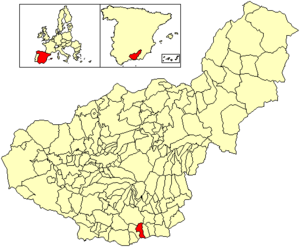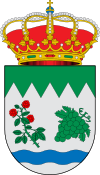Rubite facts for kids
Quick facts for kids
Rubite
|
|||
|---|---|---|---|
|
Village
|
|||
|
|||

Location of Rubite
|
|||
| Country | Spain | ||
| Province | Granada | ||
| Municipality | Rubite | ||
| Area | |||
| • Total | 28 km2 (11 sq mi) | ||
| Population
(2018)
|
|||
| • Total | 382 | ||
| • Density | 13.64/km2 (35.3/sq mi) | ||
| Time zone | UTC+1 (CET) | ||
| • Summer (DST) | UTC+2 (CEST) | ||
Rubite is a small town, also called a municipality, located in the province of Granada, Spain. It is part of the "La Costa Granadina" region in the independent community of Andalusia. Rubite is special because it sits right on the shores of the Mediterranean Sea. In 2018, about 382 people lived there. It shares its borders with other towns like Lújar, Órgiva, and Polopos.
Contents
Where is Rubite Located?
Rubite is found in the southwest part of the Granada province. It is nestled at the base of two mountain ranges: the Sierra de Lujar and the Contraviesa. The town is about 80 kilometers (about 50 miles) away from Granada city, which is the capital of the province.
Fun Traditions in Rubite
One of the oldest traditions still celebrated in Rubite is the grape harvest. This special event happens every October. During the harvest, grapes are stomped using "agobias," which are small shoes made of straw. This tradition is important because the wine from Rubite is very famous in the Alpujarra region.
A Look at Rubite's History
The name "Rubite" comes from old words. It is a mix of a Mozarabic word and the Latin word "Rubus-Robetum," which means "bramble" (a thorny bush). The first time Rubite was mentioned in history was during the Andalusian period.
Early Settlements and Changes
Between the 13th and 15th centuries, people lived in the Sierra de la Contraviesa area. In the 16th century, many North African Moors left the area. This made the town almost empty. However, in the 18th century, more people moved in, and Rubite grew a lot. Its economy also became stronger. In the 17th century, farmers were allowed to buy land and houses. They had to pay the Count of Cifuentes for this.
From Grapes to Almonds
In the 19th century, growing grapes became less popular. This forced the people of Rubite to change their main crop. They started to focus on growing almonds instead, which became very important for the town's economy.
The Story of the "Güenos"
The people from Rubite have been called "Güenos" (which means "Good Ones") for a long time. This nickname comes from a story that happened in the early 19th century. Around 1810, there was a family named "Bueno" living in Rubite. One autumn, a group of French soldiers on patrol were surprised by members of the Bueno family on their land. During the fight, some French soldiers were killed. This story quickly spread to nearby areas. The Bueno family became an example of patriotism for everyone in Rubite.
See also
 In Spanish: Rubite para niños
In Spanish: Rubite para niños



